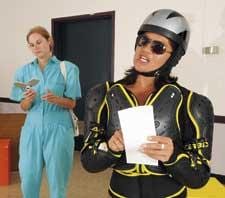What do you get when you combine lesbian cavewomen, two lesbian pirates and several lesbian cowboys?
A whole lot of laughs, says Karen White, artistic director of Leaping Thespians’ newest one-act play Once Upon a Lesbian.
The collaboratively written production takes us into the future, in a time where both heterosexuality and human touch are illegal and people only communicate through devices.
When the play’s two main characters recover a time capsule containing stories about lesbians from 100,000 BC to 2169 AD, their world and their perspective on the past are forever changed.
Over the course of a dozen scenes, the play shows audiences a different viewpoint of the past and challenges them to think about how technology is driving our culture further apart — and what might happen to human contact if we continue along this computer-focused path.
“The number one reason of how this play evolved is just how much people are using devices,” says Taylor Stutchbury, who not only co-wrote the play but acts in it and helped direct it as well.
“You know, let’s actually communicate. Let’s talk to each other,” Stutchbury says. “It seems like we’re moving farther and farther away from that as technology advances. Technology limits us. It takes away from the interaction that we physically have with people who are with us in any given moment.”
“I think it’s like we have too much contact and not enough depth,” says White. “I don’t need to know what you eat or how long you waited for the bus. I want to know what’s important to you or how you feel about issues. It’s constant superficial contact, but never deep connection.”
Despite this seemingly sombre theme, the play is actually a comedy at heart.
“I hope audiences laugh so hard their cheeks hurt,” says White.
“It’s almost making fun of a direction society could be going in,” says Leigh Burrows, who also co-wrote and helped direct the play. “If people go, ‘Wait, that got me thinking a bit’ at the end, then that’s a great bonus. But that’s not what we’re setting out to do.”
Burrows is particularly proud of the play’s eclectic sense of humour. “The comedy in each scene is quite different. And I think that’s great because that means there’s something for everybody,” she says. “If somebody likes sarcastic wit, then they’ll get it one scene. If someone likes a little slapstick, they’ll get it in another one.”
Much of the play’s comedy stems from its juxtaposition of lesbianism and conventional heterosexual settings.
“Pure and simple, these scenes are written around a time where we have traditional heterosexual images and we turn that around and put lesbian images in there,” Stutchbury says. “It’s a comedic take around the times we were ostracized to say that yeah, we were still there, you just didn’t know we were there.”
“We establish a context of a time and place, and then do something completely unexpected in that setting,” White adds. “It’s kind of about sending up those typical, iconic sorts of settings.”
If it seems like the actors’ passion shines through every line they perform, that’s because the production is a shared labour of love for the cast and crew.
“It’s not just my voice or my ideas that I’m putting down; it’s the ideas and voices of everybody in the group,” Stutchbury says. “I find it’s much more collaborative, and much more supportive.”
“The difference with doing it this way versus a traditional director saying, ‘Your blocking’s here, your lines are here, do it and that’s it’ is you become a lot more involved in the process,” says Burrows. “And I think that you just become a lot more connected to the show and a lot more connected to the end result. Like you’re a contribution rather than a pawn that’s being played out on stage.”
If the women of Leaping Thespians were to put together their own time capsule to be found by future generations, the result would be an interesting mix of images, objects and stories.
“Ultimately, I’d want to tell my story,” Stutchbury says. “And I think it’s really important to tell not just my story, but tell the stories of the people I’ve met through the course of my life.”
“One thing I would [include] would be a bundle of feminist and lesbian magazines,” White says, “just to show the progression of the ideas.”
“And a copy of Xtra West, for sure,” adds Burrows with a smile.

 Why you can trust Xtra
Why you can trust Xtra


